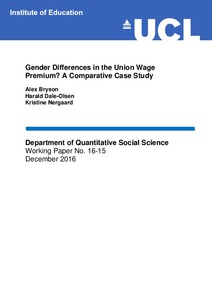Gender differences in the union wage premium? A comparative case study
"Trade unions have transformed from male-dominated organisations rooted in manufacturing to majority-female organisations serving predominantly white-collar workers, often in the public sector. Adopting a comparative case study approach using nationally representative linked employer-employee s...
| Main Authors: | , , |
|---|---|
| Institution: | ETUI-European Trade Union Institute |
| Format: | TEXT |
| Language: | English |
| Published: |
London
2016
UCL |
| Subjects: | |
| Online Access: | https://www.labourline.org/KENTIKA-761212458949-Gender-differences-in-the-unio.htm |
| Summary: | "Trade unions have transformed from male-dominated organisations rooted in manufacturing to majority-female organisations serving predominantly white-collar workers, often in the public sector. Adopting a comparative case study approach using nationally representative linked employer-employee surveys for Norway and Britain we examine whether, in keeping with a median voter model, the gender shift in union membership has resulted in differential wage returns to unionisation among men and women. In Britain, while only women receive a union wage premium, only men benefit from the increased bargaining power of their union as indicated by workplace union density. In Norway, on the other hand, although a union wage premium arises from individual union membership for men and women in male-dominated unions, in workplaces where the union is female-dominated women benefit more than men from the increased bargaining power of the union as union density rises. The findings suggest British unions continue to adopt a paternalistic attitude to representing their membership, in contrast to their more progressive counterparts in Norway." |
|---|---|
| Physical Description: | 29 p. Digital |

